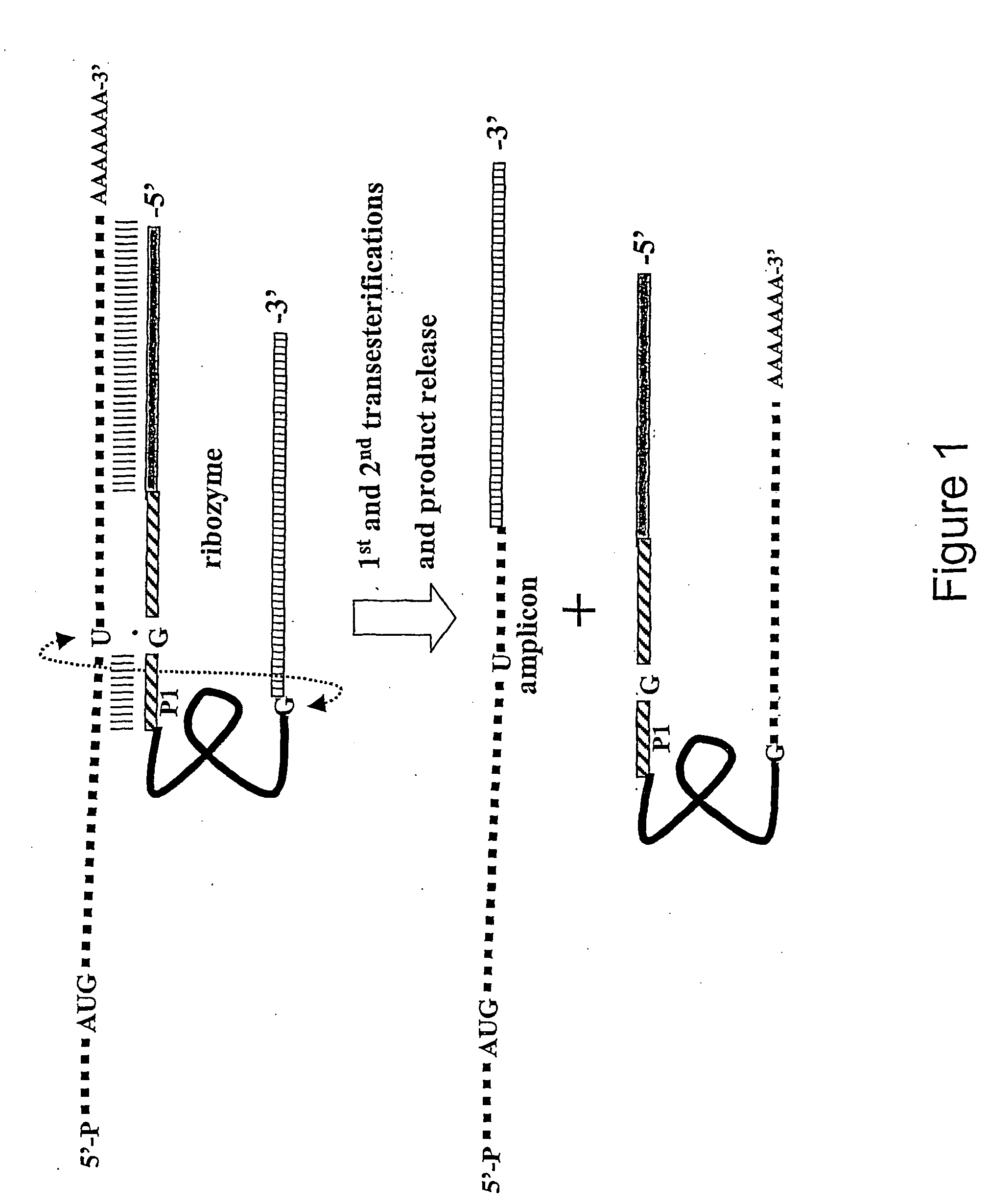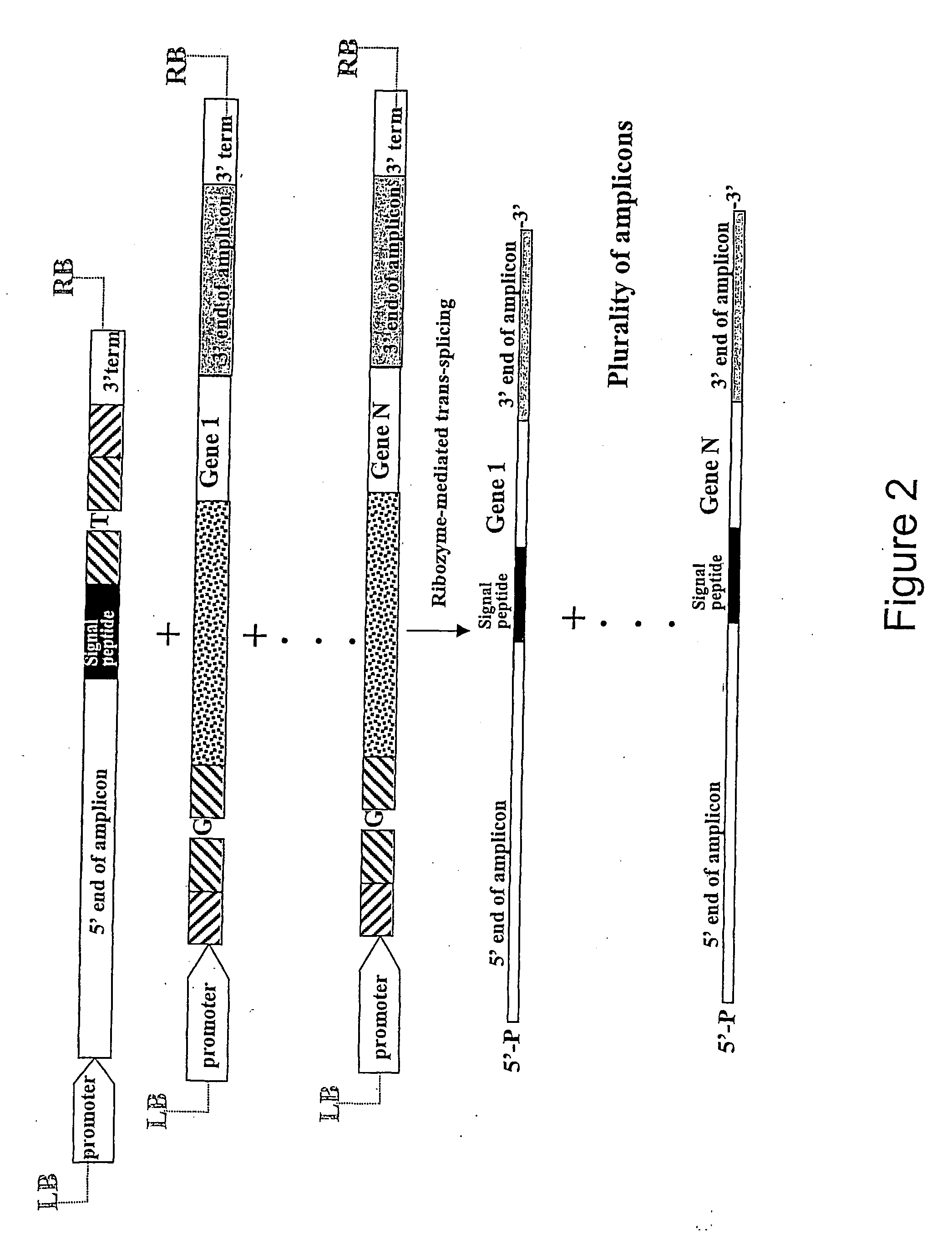Amplification vectors based on trans-splicing
a technology of transsplicing and amplification vector, applied in the field of transsplicing amplification vector, can solve the problems of low trans-splicing efficiency, low amount of trans-spliced rna in a cell, and inability of cleaving ribozymes to deplete living cells of the chosen target rna
- Summary
- Abstract
- Description
- Claims
- Application Information
AI Technical Summary
Benefits of technology
Problems solved by technology
Method used
Image
Examples
example 1
Trans-Splicing-Mediated Gene Placement Under Control of Subgenomic Promoter
[0078] Two constructs carrying the 5′ and 3′ ends of TMV amplicon were designed using standard molecular biology techniques (Sambrook, Fritsch & Maniatis, 1989, Molecular Cloning: A Laboratory Manual, Cold Spring Harbor Lab Press, Plainview, N.Y., 2nd edition). The first construct (FIG. 3, top) carries the 5′ end of a TMV amplicon containing the RdRp (RNR-dependent RNA polymerase) gene, the MP (movement protein) gene and the CP (coat protein) subgenomic promoter (SGPr) followed by sequences complementary to the variable part of artificial ribozyme (see FIGS. 3 and 7). The second construct additionally contains a full length sGFP gene and 3′NTR (non-translated region) of TMV. Schematic presentations of the constructs as well as the products of their trans-splicing are shown in FIGS. 3 (general scheme) and 7 (in detail).
Cloning of the 5′-End of the Trans-Splicing System
[0079] A part of the HPT gene (300 nu...
example 2
Trans-Splicing-Mediated Assembly of a Full Length Coding Sequence
[0092] Two constructs were designed using an approach described in EXAMPLE 1. Schematic representations of the constructs as well as the product of trans-splicing are shown in FIG. 4. The difference to example 1 is that in addition to a subgenomic promoter, the 5′ end of the pro-amplicon contains the 5′ end of GFP (sGF) (optionally with the 5′ end of the Arabidopsis Actin2 intron 1) followed by sequences recognizable by the synthetic ribozyme and a transcription termination signal. The 3′ end of pro-amplicon consists of a synthetic ribozyme designed as described by Ayre et al. (1999, Proc. Natl. Aced. Sci. USA, 96, 3507-3512), except that the 3′ end of the ribozyme consists of 3′ end of GFP (optionally preceded by 3′ end of ADH1 intron), followed by TMV 3′ non-translated region (3′NTR) and eukaryotic transcription termination region. Both constructs were placed under the control of the Arabidopsis Actin 2 promoter an...
example 3
Use of Trans-Splicing for Expression of more than One Gene in the Same Plant Cell
[0093] Two additional constructs which are similar to those described in EXAMPLE 2, but which carry two parts of the GUS gene (indicated by GU and S in FIG. 5) were obtained from pICH7942 and 7955 and placed into the binary vectors (pICBV family or pBin19, see Examples 1 and 2). The Agrobacterium strains carrying pro-amplicons with the two parts of GUS were mixed together with the Agrobacterium strains carrying two parts of GFP pro-amplicon and inoculated into leaves of growing N. benthamiana plants. The plants were monitored for GFP expression with the help of a UV lamp one week after the inoculation. Leaves expressing GFP were used for the detection of GUS activity by staining with x-gluc (Jefferson, Kavanagh & Bevan, 1987, EMBO J., 6, 3901-3907). The blue-stained sectors of the GUS activity co-localized with the sectors of GFP activity in most of the inoculated leaf tissues. A schematic representat...
PUM
| Property | Measurement | Unit |
|---|---|---|
| Length | aaaaa | aaaaa |
| Time | aaaaa | aaaaa |
| Immunogenicity | aaaaa | aaaaa |
Abstract
Description
Claims
Application Information
 Login to View More
Login to View More - R&D
- Intellectual Property
- Life Sciences
- Materials
- Tech Scout
- Unparalleled Data Quality
- Higher Quality Content
- 60% Fewer Hallucinations
Browse by: Latest US Patents, China's latest patents, Technical Efficacy Thesaurus, Application Domain, Technology Topic, Popular Technical Reports.
© 2025 PatSnap. All rights reserved.Legal|Privacy policy|Modern Slavery Act Transparency Statement|Sitemap|About US| Contact US: help@patsnap.com



